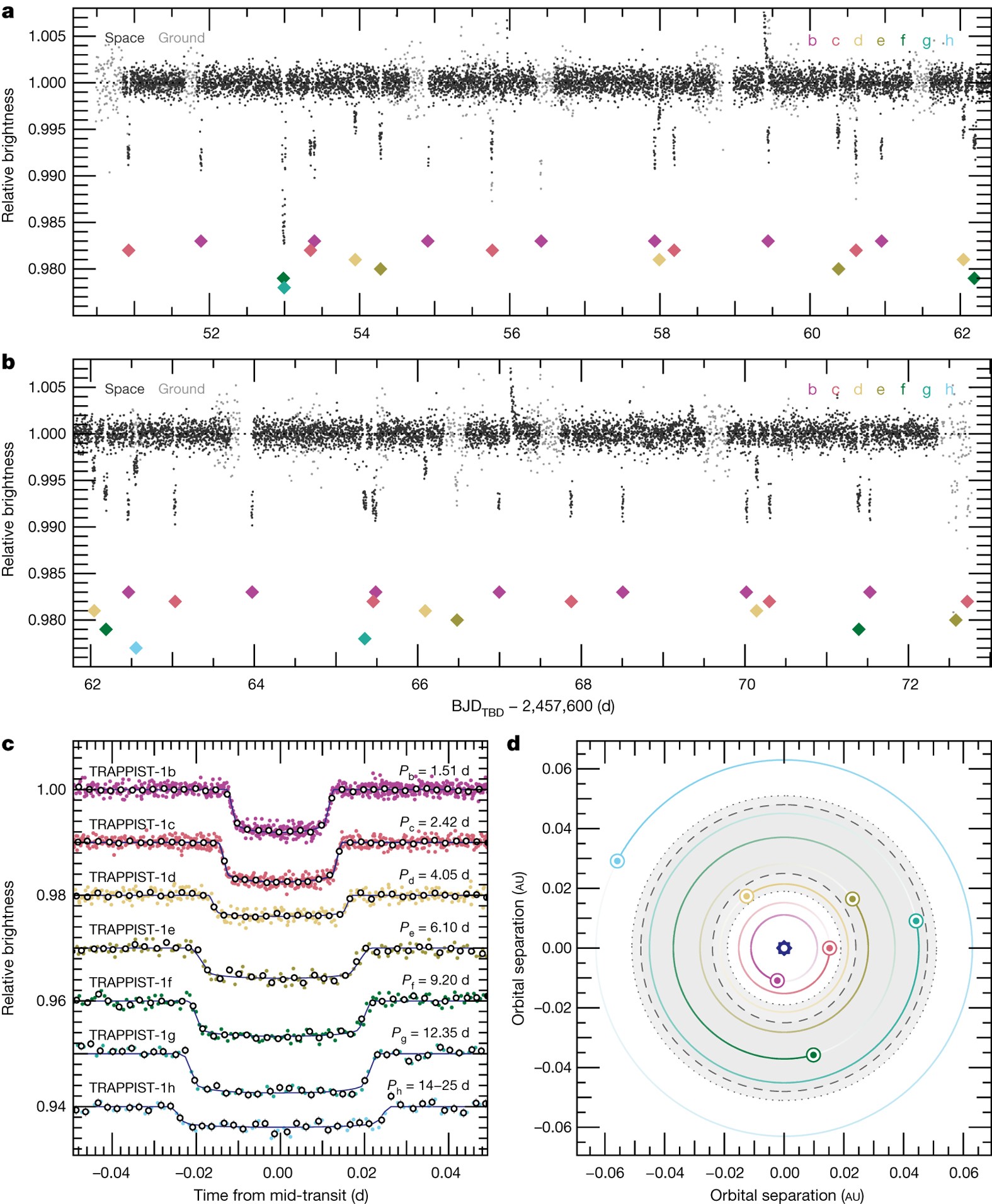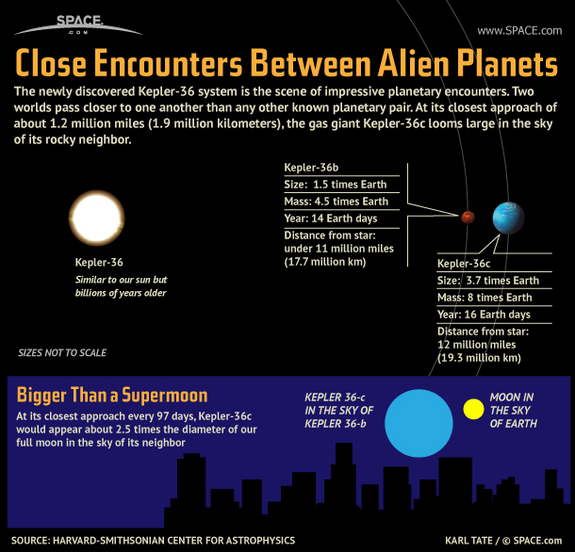Research Interests
Eric Agol creates theoretical models applied to extrasolar planet systems, as well as compact objects, binary stars, and gravitational lensing.
Diversity/inclusion:
Faculty advisor for the Pre-Major in Astronomy Program (Pre-MAP).Graduate students
- Tyler Gordon
- Bethlee Lindor (NSF GSRP Fellow)
News:
•Link to published paper on a Differentiable N-body Integrator published in Monthly Notices of the Royal Astronomical Society - with David Hernandez and Zach Langford
Work by @AgolEric, David Hernandez and Zachary Landford on a differentiable, open-source, N-body code. Really a bonanza of new ideas and codes for planetary dynamics over the last few years!https://t.co/PZvgtTKdMZ
— Phil Armitage (@philip_armitage) June 7, 2021
• Precise constraints on the TRAPPIST-1 planets
(Jan 21, 2021)
The TRAPPIST-1 star is home to the largest batch of roughly Earth-size planets ever found. Now we know even more about the densities of these seven rocky worlds.
— NASA Exoplanets (@NASAExoplanets) January 22, 2021
And the composition of the TRAPPIST-1 planets could be notably different than Earth's! https://t.co/h8cw3VY2PS pic.twitter.com/K4TOgYgYE2
# # # https://t.co/l5pFma2axP
— Natalie Batalha (@nbatalha) January 23, 2021
See the open access paper in the
 right here, and a University of Washington press release here.
right here, and a University of Washington press release here.
Exciting results from @NASAspitzer observations of the TRAPPIST-1 system, presented in two #Exo3 talks by @ElsaDucrot and @AgolEric, respectively! pic.twitter.com/VHxezb2fWx
— Michael Wong (@miquai) July 27, 2020
Former Undergraduate, Graduate students and Postdocs:
- Sarah Ballard (University of Florida, Assistant Professor);
- Nicolas Cowan (Assistant Professor at McGill University);
- Jason Dexter (Assistant Professor at University of Colorado);
- Ian Dobbs-Dixon (Assistant Professor at New York University Abu Dhabi);
- Andrew Eberhardt (Graduate Student at Stanford);
- Dan Foreman-Mackey (Associate Research Scientist at Simons/Flatiron Center for Computational Astronomy);
- Tiffany Jansen (Graduate Student at Columbia University);
- Amy Kimball (Postdoctoral Fellow at National Radio Astronomy Observatory);
- Ethan Kruse (Postdoctoral Fellow at Goddard Space Flight Center);
- Praveen Kundurthy (Analytics at Blue Origin);
- Brianna Lacy (Graduate Student at Princeton);
- Brian Lee (Assistant Professor at Santa Fe College);
- Rodrigo Luger (Postdoctoral Fellow at Simons/Flatiron Center for Computational Astronomy);
- Chelsea MacLeod (Postdoctoral Fellow at Harvard-Smithsonian Center for Astrophysics);
- Carl Majeau (Programmer);
- Laura Mayorga (Harvard Future Faculty Leaders fellow);
- Brett Morris (NCCR Planets Postdoc at Universitat Bern, Switzerland);
- Jeremiah Murphy (Assistant Professor at Florida State University);
- Devin Silvia (Teaching Specialist at Michigan State University);
- Jason Steffen (Assistant Professor at University of Nevada Las Vegas);
- Maria Steinrueck (Graduate Student at University of Arizona);
- Diana Windemuth (NESSF Fellow)
- John Wisniewski (Associate Professor at University of Oklahoma).
Old News:
• Image of Black Hole Shadow (April 2019). The Event Horizon Telescope (EHT) captured a radio image of the synchrotron emission surrounding the black hole in the Messier 87 Galaxy, realizing an idea we worked out 20+ years ago which inspired the EHT (Falcke, Melia & Agol 2000)
Here's what @AgolEric predicted the shadow of a black hole would look like 20 years ago, and here's what it actually looks like.
— Ian Agol (@agolian) April 10, 2019
Congrats Eric, @gbower314, and the Event Horizon Telescope team! pic.twitter.com/F4vpKAQT06
• Hundreds of new planet candidates found in Kepler data
• Period of seventh planet in Trappist-1 found with K2. Link to paper.
• TRAPPIST-1 hosts seven Earth-sized planets, three temperate.
• Website dedicated to TRAPPIST-1
Figure 1 from the paper: 
• We (Tiffany Jansen, Brianna Lacy, Ty Robinson and Vikki Meadows) proposed a new approach to detecting exomoons with the future 'High-Definition Space Telescope' using the astrometric offset between wavelengths dominated by a planet versus wavelengths dominated by its moon. See astrobites for a summary by Michael Zevin.
• Joint IAS/Princeton astrophysics colloquium in Fall 2015, which is recorded here.
• Quoted in a New York Times article on the Event Horizon Telescope
• Talk on April 30, 2014 on 'The Habitability of White Dwarfs' at the conference `Habitable Worlds Across Time and Space' at the Space Telescope Science Institute in Baltimore, MD. Here is a webcast of the talk.
Discoveries:
• Graduate student Ethan Kruse found the first `self-lensing' binary star with the Kepler spacecraft. In 2003 I predicted this should be found with Kepler, at the same time as Sahu & Gilliland, although self-lensing binaries were mentioned as early as 1969 by Trimble & Thorne, 1971 by Leibovitz & Hube, and 1973 by André Maeder. The system is composed of a white dwarf and sun-like star.
He explains the find here. Here is an image I made showing what this system might look like up close (with a real image of the Sun taken by the NASA SDO/HMI spacecraft as a proxy for theG dwarf companion to the white dwarf):
 Here is a preprint, and here is the supplementary online material.
Here is a preprint, and here is the supplementary online material.
And here is a movie that shows what the gravitational lensing effect might look like in this system (elapsed time in movie is about five hours): White dwarf lensing G dwarf.
• Here is a description of our discovery of a planet system with seven transiting planets: Discovery of seven planet system, and confirmation of more than 700 planets.
• Kepler-62f: the first potentially rocky, "habitable-zone" exoplanet found with Kepler.

The second-smallest diameter confirmed "habitable-zone" planet, 1.4 times Earth, was found by me, and confirmed by a large team of scientists using the Kepler spacecraft, Kepler-62f
The discovery was announced in May, 2013 in Science magazine: Borucki, Agol et al., 2013, Science. Astronomers (and astrobiologists) are excited about this find, and its possible implications for exo-biology.
• Here is a description of the first multi-planet system orbiting two stars that we just found: Kepler-47

• Here is a graphic depicting more than two dozen planets that I helped to confirm, led by my former PhD student, Jason Steffen:
• We discovered two planets that orbit closest to one another of any planets found to date, Kepler-36:
• Here is a news article about a secondary eclipse map of
exoplanet HD 189733b:
• I proposed in 2011 that 'habitable' planets might be found orbiting white dwarf stars:
• With my collaborators, I have:
- First proposed with Heino Falcke and Fulvio Melia that radio VLBI could be used to see the shadow of the black hole at the center of the Milky Way Galaxy. See article in the New York Times and Science Magazine.
- Modelled black hole accretion disks with the goal of explaining the spectra and variability of active galaxies. Download model atmospheres here!
- Developed a technique for imaging quasars on very fine scales using gravitational lensing.
- Pointed out how to find isolated black holes and white dwarfs in binaries in our own galaxy using gravitational microlensing and X-ray surveys.
- Made multi-wavelength observations of the gravitational lens known as the 'Einstein Cross'.
- Made polarimetric and infrared measurements of a T-Tauri star which eclipses once every 48 days.
- Developed computer code for modeling transiting extrasolar planets.
- Proposed using timing of transits to search for low-mass planets.
- He has been probing weather on extrasolar planets by measuring the phases of extrasolar planets throughout their orbits using the Spitzer Space telescope. With graduate student Nick Cowan, he used this data to create the first crude 'map' of extrasolar planet HD 189733 B, as well as create an "alien map" of planet Earth using the EPOXI satellite looking back at Planet Earth, as described here.
- Here is a radio interview on KUOW. Look at Research to learn more.
Contact
| Office: | B370 Physics and Astronomy Building |
| 3910 15th Avenue NE | |
| Seattle, WA 98105 | |
| Phone: | (206) 543-7106 |
| FAX: | (206) 685-0403 |
| Email: | agol AT uw.edu |
| Mail: | Astronomy Department |
| Box 351580 | |
| University of Washington | |
| Seattle, WA 98195 |


